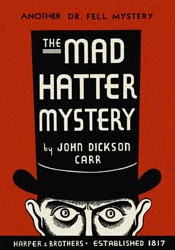 First US edition | |
| Author | John Dickson Carr |
|---|---|
| Language | English |
| Series | Gideon Fell |
| Genre | Mystery fiction, Detective fiction |
| Publisher | Hamish Hamilton (UK) & Harper (USA) |
Publication date | 1933 |
| Publication place | United Kingdom |
| Media type | Print (Hardback & Paperback) |
| Pages | 256 (Dell #706, paperback edition, 1941) |
| Preceded by | Hag's Nook |
| Followed by | The Eight of Swords |
The Mad Hatter Mystery, first published in 1933, is a detective story by American writer John Dickson Carr, featuring his series detective Gideon Fell. This novel is a mystery of the type known as a whodunnit.